
piston_damage
.pdf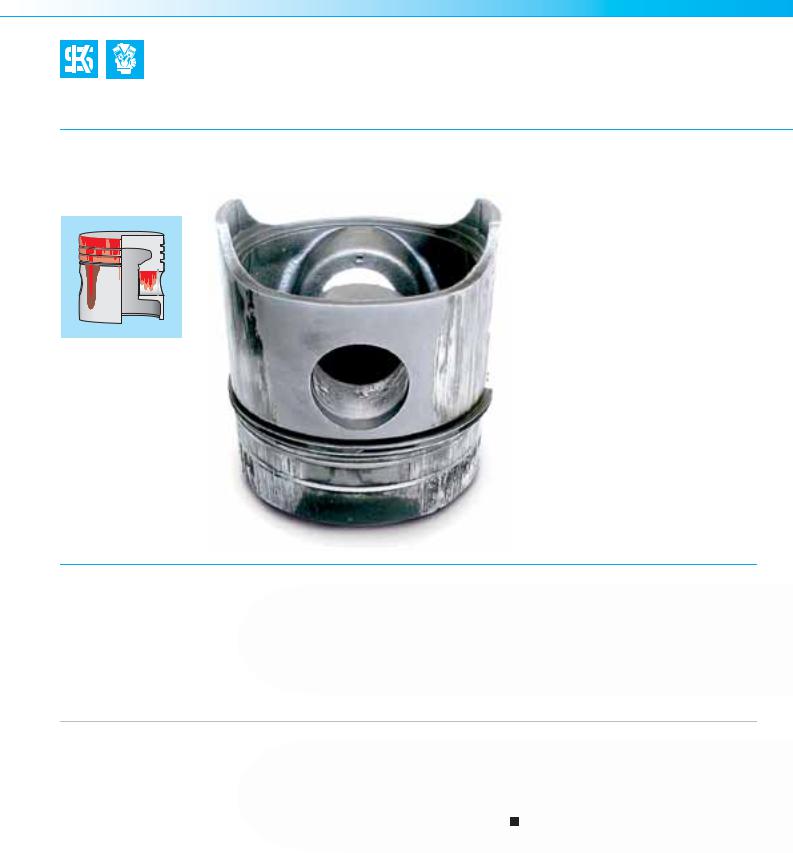
Piston damages
Description – assessment – causes
3.8.3 Seizure in the piston pin bore (with piston skirt seizure)
Description of the damage
The piston has seized all around its circumference with the main focus on the piston top land (Fig. 1). The compression rings have become blocked in the ring groves. Seizure marks are present in both piston pin bores.
Fig. 1
Damage assessment
As the main focus of the seizures is on the piston top land, it is safe to assume that this is where the damage obviously originated as a result of abnormal combustion. Subsequently the
piston rings seized up, and the seizure marks spread increasingly down onto the skirt. The combustion gases which flew past the seized compression rings then heated up the piston
to such a point that eventually the oil film in the piston pin bed became ineffective, and seizures developed here as well.
Possible causes for the damage
•Abnormal combustion which lead to a seizure due to the combined effects of insufficient clearance and lack of lubrication on the piston top
land and skirt and subsequently also cause seizures in the piston pin bed.
MSI Motor Service International |
Piston damages – Recognising and rectifying | 61 |

Piston damages
Description – assessment – causes
3.9 Piston noises
3.9.0 General information about piston noises
Piston running noises can be caused by a wide variety of influences during operation of the engine.
•Tilting of the pistons due to excessive clearance:
The piston can tilt if the dimensions of the cylinder bore are too large or as a result of wear / material breakdown, stimulated by the pendulum motion of the connecting rod and the change of bearing surface of the piston in the cylinder, and the piston hits hard against the cylinder running surface (with the piston crown in particular) as a result.
•Tilting of the piston caused by insufficient clearance in the piston pin bed:
The clearance between the piston pin and the small-end bush can either be too small by design, or it may have been eliminated by jamming or warping in operation. This can happen particularly as a result of connecting rod misalignment (bending and/or twisting).
•Piston striking in the direction of the piston pin:
Any lateral striking of the cylinder bore by the piston mostly stems from the connecting rod. Due to misalignment of the connecting rod (bending or twisting in particular), the piston performs a pendulum movement during its upward/ downward stroke in the longitudinal axis of the engine, as a result of which the piston strikes in an alternating sequence against the cylinder. Asymmetrical connecting rods or non-concentric support for the piston by the connecting rod have the same effect.
•Piston pin striking alternately against the piston pin circlips:
Axial thrust in the piston pin is always the result of an alignment error between the axis of the piston pin and the crankshaft axis. As described in the previous point, distortion or twisting of the connecting rod and asymmetry of the connecting rod are the most common causes for this type of fault. However, excessive big-end bearing clearances (big-end bearing journal on the crankshaft) can cause a lateral pendulum movement of the connecting rod, particularly at lower engine speeds. The piston pin is skewed as a result in the connecting small end rod and is pushed back and forth in the piston pin bore due to the pendulum motion of the piston. The piston pin strikes against the piston pin circlips as a consequence.
•The correct installation direction of the piston was ignored:
In order to smoothen the change of the contact surface of the piston before TDC and before the power stroke, the piston pin axis is offset by some tenth of a millimetre towards the piston pressure side. If the piston is inserted the wrong way round (i.e. rotated by 180°) and therefore the piston pin axis is offset to the wrong direction, then the piston changes bearing surface at the wrong time. The piston tilting is then much heavier and much noisier.
62 | Piston damages – Recognising and rectifying |
MSI Motor Service International |
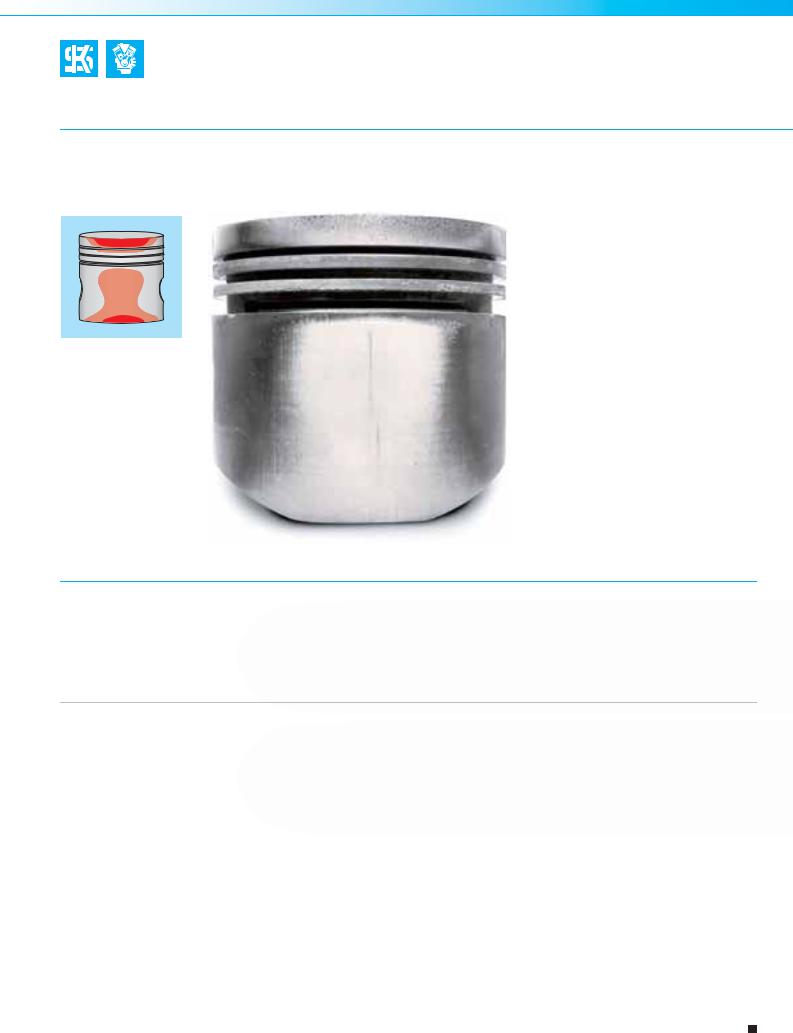
Piston damages
Description – assessment – causes
3.9.1 Radial impact points on the piston top land
Description of the damage
The piston top land has impact marks in the tilt direction (Fig. 1). The piston skirt displays a more pronounced running pattern to the top and bottom than in the middle of the skirt.
Fig. 1
Damage assessment
One type of piston noise which is |
alternating sides of the cylinder run- |
perceived as particularly annoying is |
ning surface. Depending on the cause, |
caused by the piston crown striking |
the piston top land strikes either in |
the tilt direction or in the oval plane (piston pin direction) against the cylinder wall.
Possible damage reasons for impact points in the tilt direction
•Excessive installation clearances and hence poor guidance of the piston due to excessively large bored or honed cylinders.
•The installation direction was not observed for pistons with a piston pin axis offset.
•Tight connection between piston and conrod: As a result of the lack of clearance, the piston top land strikes against the cylinder running surface in the so-called tilt direction.
Reasons for this are:
•Insufficient clearance in the connecting rod small end or in the piston pin bore.
MSI Motor Service International
•Excessively narrow fit of the piston pin in the small-end bush (shrink-fit connecting rod).
If fit of the piston pin is too tight in the connecting rod small end, then the connecting rod small end is deformed in the direction of the narrowest wall thickness when the piston pin is shrunk and installed. The connecting rod small end and the piston pin take on an oval form in the process.
•On shrink-fit connecting rods: restriction of the clearance between the piston pin and the piston caused by distortion of the piston pin as a result of the bore in the connecting rod small end no longer being geometrically round.
•Seized piston pin
Possible damage reasons for impact points in the piston pin direction
•In case of misalignment of the connecting rod, particularly in the case of a twisted connecting rod or excessive big-end bearing clearances, the piston crown moves in a pendulum motion in the piston pin direction and strikes against the cylinder wall.
•Connecting rod alignment faults (distortion/twisting): This results in alternating axial thrust in the piston pin, as a result of which the piston pin strikes alternately against the circlips at either end.
Piston damages – Recognising and rectifying | 63
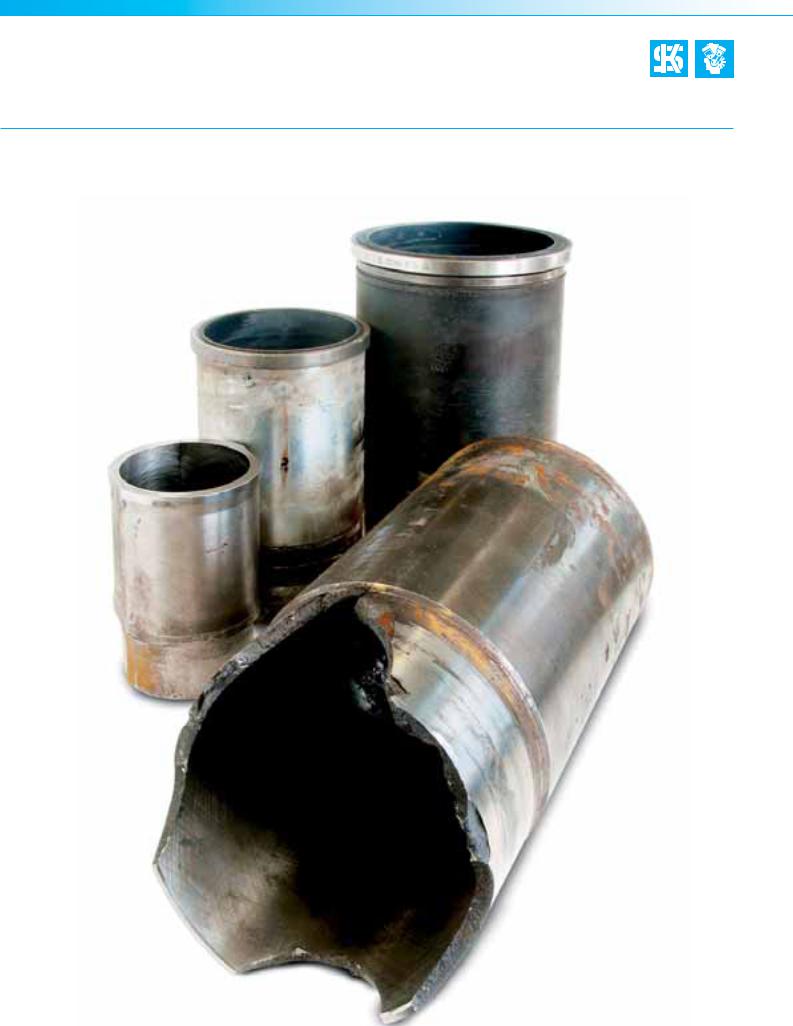
Piston damages
Description – assessment – causes
3.10 Cylinders and cylinder liners
64 | Piston damages – Recognising and rectifying |
MSI Motor Service International |
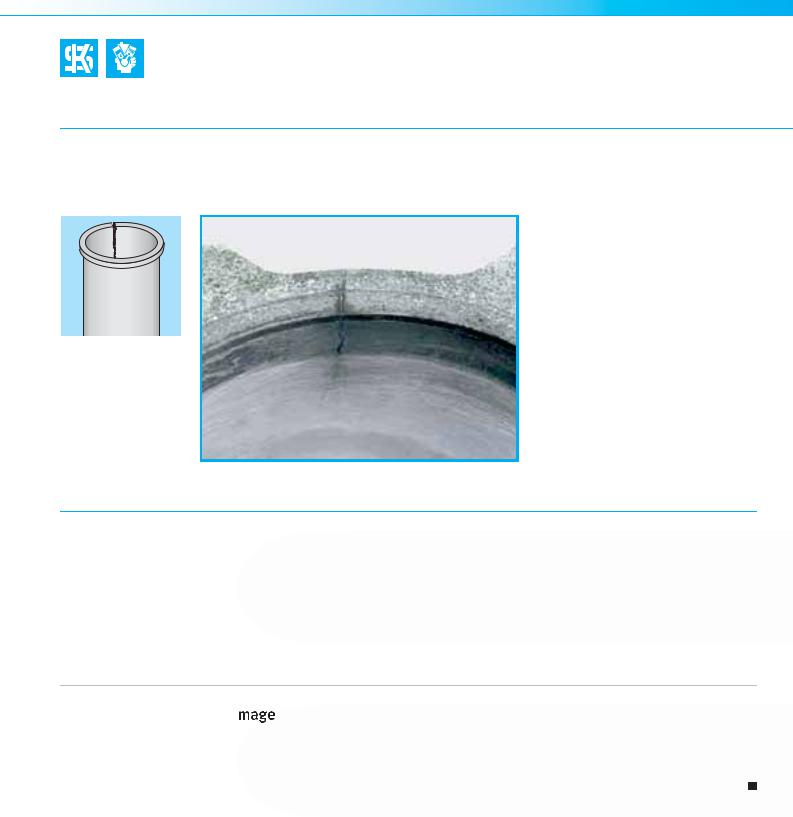
Piston damages
Description – assessment – causes
3.10.1 Longitudinal cylinder liner cracks
Description of the damage
The crack is usually vertical and usually extends in a vertical direction from the liner flange. Dry liners can also be affected because of their relatively thin cylinder wall thickness.
Fig. 1
Damage assessment
Cylinder liner cracks of this nature are frequently caused by careless handling (e.g. the results of impacts or blows). Even if the liner does not suffer visible damage straight away, a microscopic crack or notch can
generate a fracture during subsequent operation of the engine and therefore cause failure of the component. Similarly to the case described above, incorrect contact of the flange and dirt between the cylinder liner and the cyl-
inder block can also cause this type of damage. The longitudinal cracks often occur in conjunction with lateral cracks in cases of longitudinal cracks caused by faulty flange contact surfaces.
Possible causes for the da
•Improper and careless handling of the cylinder liners during transport or repairs and associated damage due to cracks or notches.
•Hydraulic locks
•Foreign bodies underneath sealing surfaces.
•Faulty flange contact. (Refer also to point “3.10.2 Torn off flange on the cylinder liner”)
MSI Motor Service International |
Piston damages – Recognising and rectifying | 65 |
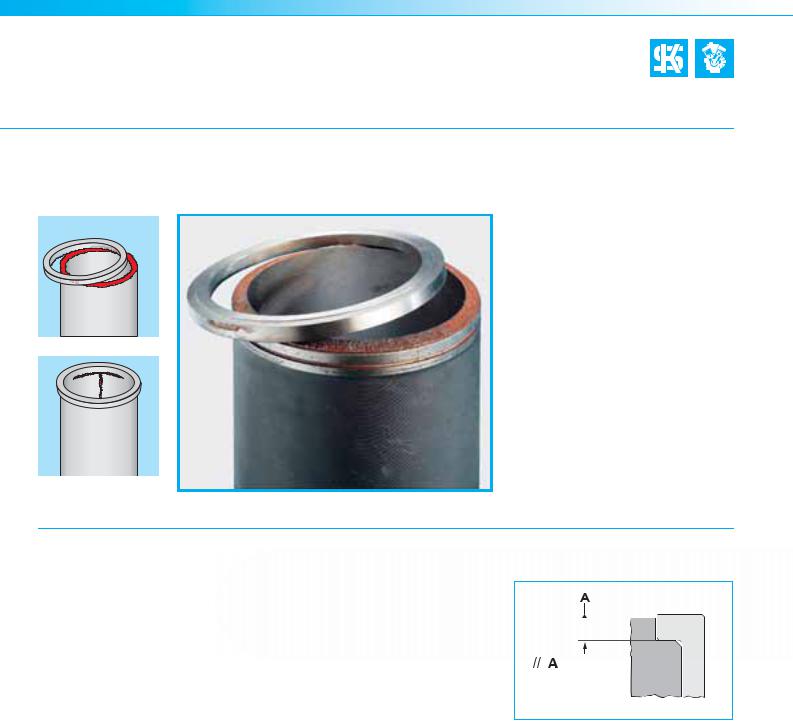
Piston damages
Description – assessment – causes
3.10.2 Torn off flange on the cylinder liner
Description of the damage
The complete flange of the cylinder liner has been torn off (Fig. 1). The flange crack starts at the base of the lower edge of the liner flange and extends upwards under an angle of approx. 30°.
Fig. 1
Damage assessment
This type of damage is caused by bending moments which arise as a result of improper installation (dirt / form defects). There are many reasons which can cause this type of fracture. In most cases, the cylinder liner flange is already pressed off when the cylinder head is tightened down. On the latest generations of engines for commercial vehicles with unit injectors or common rail fuel injection systems, the cylinder block is subjected to increasing loads as a result of the increasing combustion pressures. The use of very hard steel cylinder head gaskets on these two engine types can cause distortion of the crankcase in the area of the cylinder liner contact surface after the engine has been in operation for a long time. The distortion of the contact surface cannot be
detected by visual inspection alone unless the appropriate measuring aids are used.
One simple way to check for this
distortion is the use of bearing ink. The ink is thinly applied around the
contact surface of the liner flange on the cylinder block. The new liner is
then inserted without gaskets and Fig. 2 pressed onto the seat. The liner is
then removed again. The contact surface on the liner should now be evenly coated with ink around the entire circumference. The liner seat needs to be reworked if any areas have not come into contact with ink. This reworking is best performed on a stationary horizontal boring machine or with a mobile liner flange lathe. This is the only way to ensure parallelism to the upper housing surface (Fig. 2).
66 | Piston damages – Recognising and rectifying |
MSI Motor Service International |
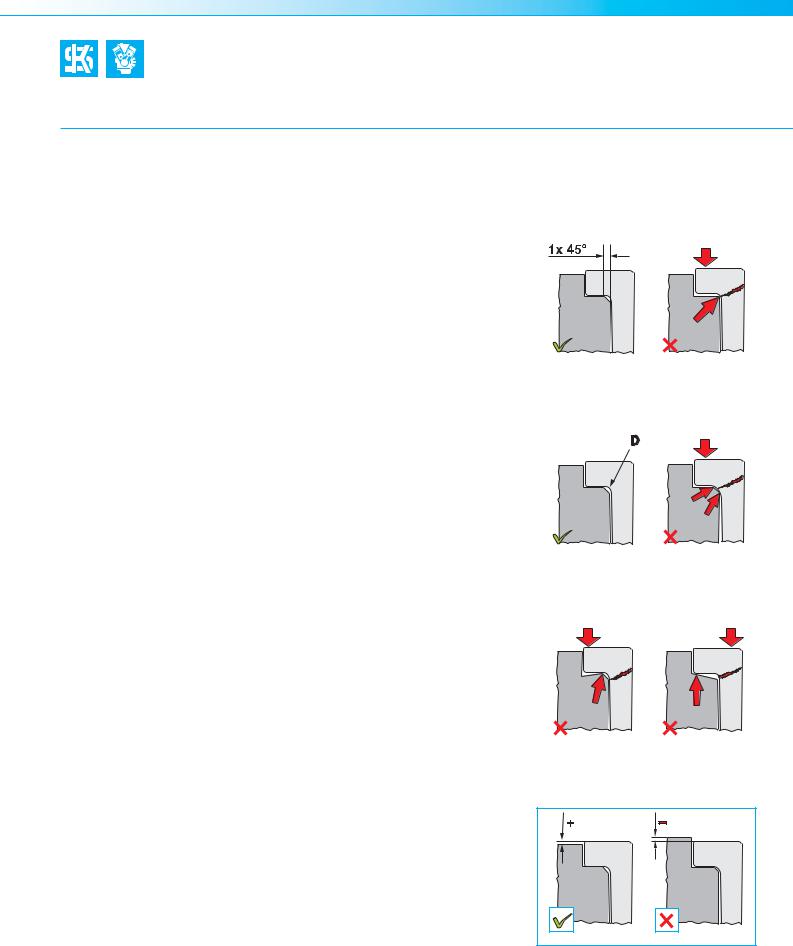
Piston damages
Description – assessment – causes
Possible causes for the damage
•Use of non-approved gaskets (in some cases the aftermarket gaskets have different shapes and diameters).
•Non-compliance with the engine manufacturer’s recommended tightening torques and tightening angles.
•Failure to carefully clean any dirt off the liner seat in the cylinder block.
•Failure to ensure that the flange contact surface is perfectly rectangular and/or parallel (Figs. 2 and 5).
•Reworking of the flange seat without due care for the proper form. The form of the liner seat must correspond to the form of the cylinder liner.
The transition from the flange surface to the precision-fit seat diameter must have a bevelled edge of 0.5–1.0 mm X 45° to prevent the channel on the liner flange from making contact with the edge. If this is not ensured then it is very easy for the flange to be pressed off when the cylinder head is tightened down (Fig. 3).
Furthermore, it must also be ensured that the shape of the liner seat radius (D) in Fig. 4 is not chosen so large as to prevent the liner from bearing loads at the inner or outer edge on the liner flange.
•If the liner flange does not project |
|
|
|
|
|
|
|
||
by the prescribed dimension from |
|
|
|
|
|
|
|
||
|
|
|
|
|
|
|
|||
the cylinder sealing surface, or if |
|
|
|
|
|
|
|
||
it is slightly recessed (Fig. 6), then |
|
|
|
|
|
|
|
||
the liner is not pressed onto the |
|
|
|
|
|
|
|
||
liner seat with enough force during |
|
|
|
|
|
|
|
||
|
|
|
|
|
|
|
|||
installation. During operation, this |
|
|
|
|
|
|
|
||
can cause the liner to also adopt |
|
|
|
|
|
|
|
||
Fig. 3 |
|
|
|||||||
a pendulum motion as a result of |
|
|
|||||||
|
|
|
|
|
|
|
|||
the pendulum motion of the piston. |
|
|
|
|
|
|
|
||
The resulting forces acting on the |
|
|
|
|
|
|
|
||
liner flange can cause it to be torn |
|
|
|
|
|
|
|
||
off. If it is necessary to rework the |
|
|
|
|
|
|
|
||
liner flange contact surface during a |
|
|
|
|
|
|
|
||
major engine overhaul, it is possible |
|
|
|
|
|
|
|
||
to either insert steel adjustment |
|
|
|
|
|
|
|
||
shims underneath or use a liner with |
|
|
|
|
|
|
|
||
|
|
|
|
|
|
|
|||
an oversized flange to provide the |
|
|
|
|
|
|
|
||
necessary protrusion of the liner |
|
|
|
|
|
|
|
||
Fig. 4 |
|
|
|||||||
over the cylinder surface. The solu- |
|
|
|||||||
|
|
|
|
|
|
|
|||
tion involving a liner with oversized |
|
|
|
|
|
|
|
||
flange* is preferable to the option of |
|
|
|
|
|
|
|
||
inserting adjustment shims under- |
|
|
|
|
|
|
|
||
neath, as it is technically the more |
|
|
|
|
|
|
|
||
sturdy solution. |
|
|
|
|
|
|
|
||
|
|
|
|
|
|
|
|
|
|
|
|
|
|
|
|
|
|
|
|
|
|
|
|
|
|
|
|
|
|
|
|
|
|
|
|
|
|
|
|
|
|
|
|
|
|
|
|
|
|
Fig. 5
Fig. 6
*MSI supply cylinder liners with oversized flanges for most engines. Please refer to our current catalogue “Pistons, Cylinders and Kit Sets”.
MSI Motor Service International |
Piston damages – Recognising and rectifying | 67 |
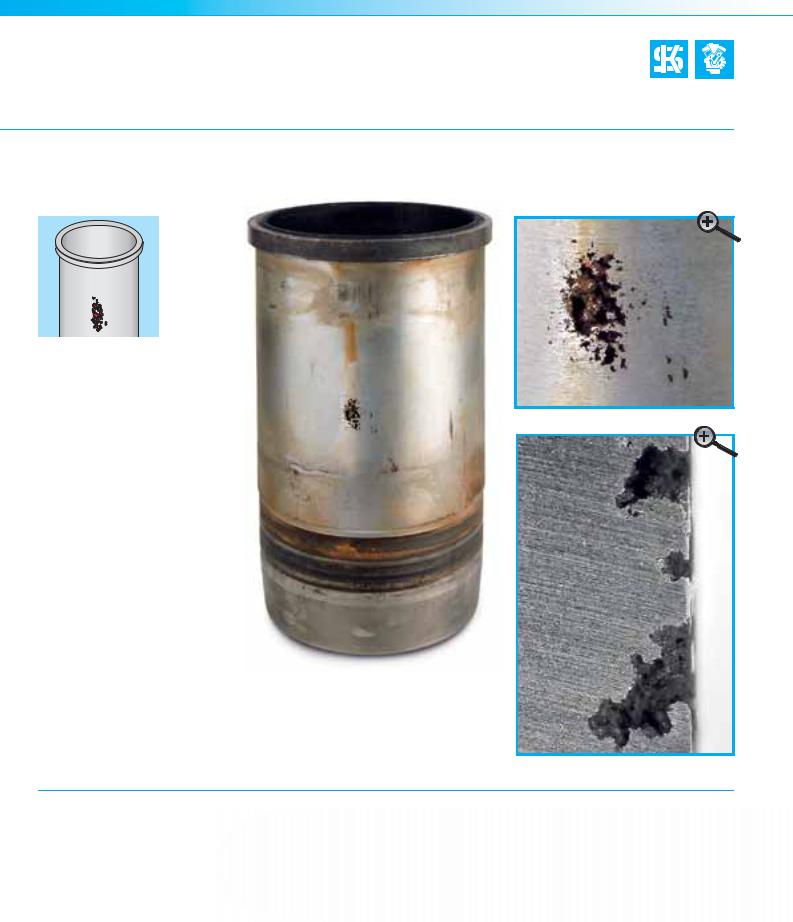
Piston damages
Description – assessment – causes
3.10.3 Cavitation on cylinder liners
Description of the damage
The wet cylinder liner displays
severe cavitation in the area of Fig. 2 the water jacket. The damage has
progressed so far that there is already one hole into the inside of the cylinder.
Fig. 1
Fig. 3 cross section of liner
Damage assessment
Cavitation is more likely to occur in the tilt direction of the piston (on the pressure or counterpressure side) and is triggered by vibrations of the cylinder wall. These high-frequency vibrations are caused by the combustion pressure, the lateral forces exerted by the pistons and the piston’s change of bearing surfaces at TDC and BDC. If the cooling liquid is no longer capable of following the vibrations of the cylinder
wall, this results in temporary separation of the water film from the cylinder liner. Tiny vapour bubbles form in the resulting area of low pressure, and when the cylinder wall vibrates back at exceptionally high speed, these bubbles implode. The water displaced by the bubbles hits the surface of the cylinder very suddenly when the tiny bubbles implode. The impact energy generated in this way dissolves tiny
particles from the surface of the cylinder. With time, complete holes are torn out (washed out). A special feature of cavitation is the fact that the size of the holes increases further inside the material (Fig. 3), resulting in the cavities from which the name of this type of damage is taken.
68 | Piston damages – Recognising and rectifying |
MSI Motor Service International |

Piston damages
Description – assessment – causes
Possible causes for the damage
•Failure to comply with the correct piston clearance (re-installation of pistons which have already been used, or use of cylinders manufactured too large).
•Poor or inaccurate seating of the liner in the housing.
•The required permanent anti-freeze protection or corresponding additives in the cooling water are missing. The anti-corrosion protection agent contains inhibitors which prevent foaming. However, these inhibitors are gradually used up with time. Therefore it is necessary to change the anti-corrosion protection agent every 2 years and to use the correct mixture ratio.
•Use of unsuitable coolants such as salt water (sea water), aggressive or acidic water or other liquids.
•Lack of pre-pressure in the cooling system: The required radiator prepressure cannot be maintained as a result of using an unsuitable radiator cap (not enough pressure can be maintained due to a defective pressure relief valve) or because of a leak in the cooling system. If the pre-pressure in the cooling system is in accordance with the requirements, the boiling temperature of the coolant is higher than under atmospheric pressure. Although the pre-pressure in the cooling system cannot eliminate the cause for formation of the tiny vapour bubbles altogether, it can at least inhibit the formation of the bubbles.
•Engine operating temperature too low: If due to particular operating conditions or thermostat defects the engine does not reach its normal operating temperature, no excess pressure can build up in the cooling system because of the reduced thermal expansion of the coolant. The low operating temperature
also means that the pistons do not expand in the required manner. As a result they run with increased piston clearance. Both cases assist the formation of the tiny bubbles and hence the effects of cavitation.
MSI Motor Service International |
Piston damages – Recognising and rectifying | 69 |
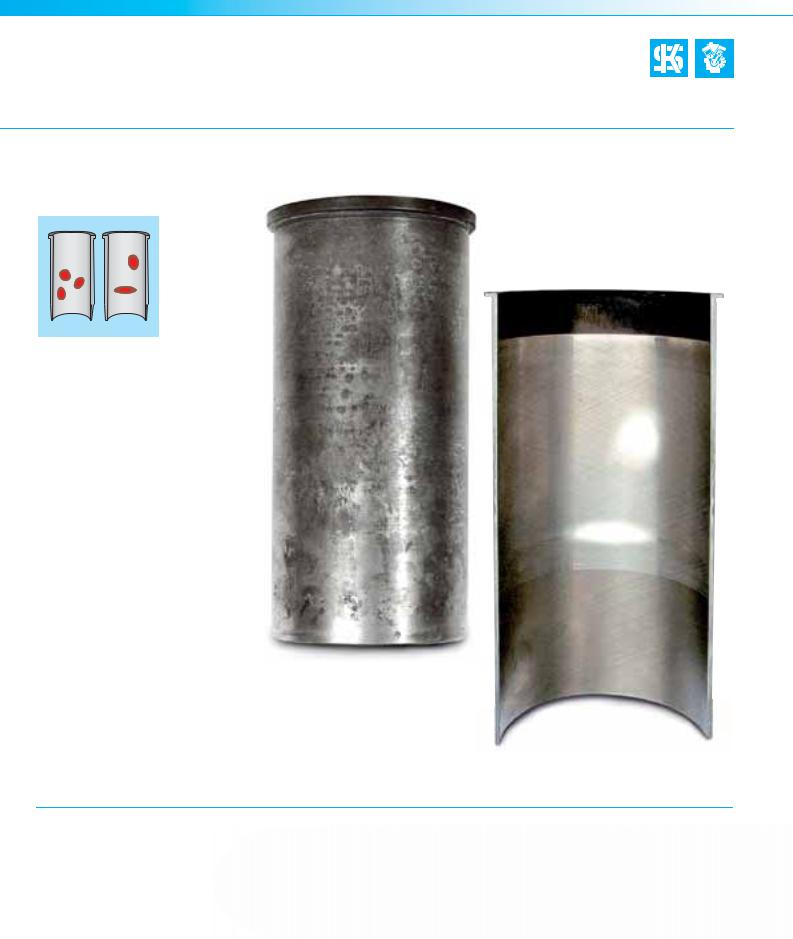
Piston damages
Description – assessment – causes
3.10.4 Uneven cylinder wear
Description of the damage
The cylinder bores display an uneven wear pattern with individual brightly polished areas (Fig. 2). No wear or rubbing marks are evident on the pistons. The engine was loosing oil at the sealing points, in particular the radial oil seals. Fig. 1 clearly shows the corrosion on the outer diameter of the cylinder liner which caused the out-of-roundness of the cylinder when it was installed.
Fig. 1
Fig. 2
Damage assessment
Highly polished irregular running patterns on the running surfaces in the cylinders always indicate cylinder distortion. Wet or dry cylinder liners in particular can already be distorted immediately after installation. If the cylinder is distorted the piston rings can neither provide a perfectly tight seal
for the oil nor the combustion gases. The oil escapes past the piston rings into the combustion chamber, where it is burned. The increasing quantities of combustion gases flowing past the piston causes the pressure in the crankcase to rise. This overpressure causes oil loss at various sealing
points around the engine, particularly at the radial oil seals. Furthermore, oil is forced through the valve guides into the intake and exhaust ducts, from where it is then sucked in by the engine and burned or eliminated.
70 | Piston damages – Recognising and rectifying |
MSI Motor Service International |
